1. Introduction
According to international statistics, the total CO₂ emissions from maritime shipping increased from 909 million tons in 2013 to 932 million tons in 2015, reflecting a growth of 2.46%. Specifically, emissions from international vessels, domestic ships, and fishing boats rose by 1.39%, 6.81%, and 16.97%, respectively [1]. In response to this upward trend, the International Maritime Organization (IMO) introduced two regulatory frameworks in 2023—namely, the Energy Efficiency Existing Ship Index (EEXI) and the Carbon Intensity Indicator (CII)—to enforce more stringent global standards for energy efficiency and carbon emissions in the shipping industry. While these frameworks support the industry's green transition, they also introduce considerable challenges, including increased operational costs, market segmentation, and the need to rethink traditional operational strategies. Moreover, under the IMO's revised greenhouse gas emission reduction strategy, it is projected that by 2030, nearly 89% of large bulk carriers may require rectification due to receiving a D or E rating under the CII scheme.
2. Theoretical foundations and problem modeling
2.1. Introduction and computational modeling related to EEXI and CII
EEXI is a ship energy efficiency index introduced by IMO to reduce carbon emissions from shipping. It determines compliance by comparing each ship's Attained EEXI with the Required EEXI for the ship's size. If the Attained EEXI ≤ Required EEXI, the ship can continue to operate; if it exceeds the standard, it will need to be taken out of service or take improvement measures. For some ships, the EEXI is particularly important and is considered as a "trade license" [2].In order to satisfy the universality of the EEXI calculation model for all ship types, the common calculation formula is as follows:
EEXI =
2.2. Waste heat system architecture for quadruple supply
2.2.1. Overall design
This project designs a new type of "cooling, heating, electricity and desalination" quadruple-supply retrofit program applicable to the low-carbon transformation of old ships, and the design process is shown in Figure 1. Taking a Wärtsilä ship as an example, its 350℃ flue gas waste heat is recovered by Rankine cycle generator set, and the high temperature steam from the boiler is driven to power generation, cooling, heating and seawater desalination modules after shunt to realize the synergistic utilization of multiple energies. In order to balance the supply and demand of each equipment, this project introduces an automatic control system to regulate the flow of each circuit, based on the Transformer-LSTM model carbon prediction and multi-objective optimization dynamic scheduling for the parameter, to achieve the "cold, heat, electricity, desalination and carbon" five-dimensional cross-media regulation.
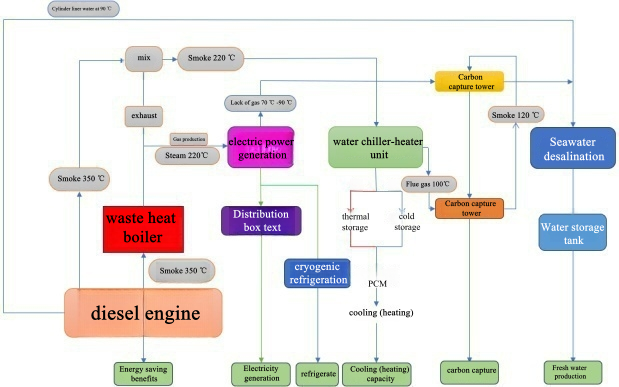
2.2.2. Working principle of each module
In order to simulate the real environment of the ship's nacelle and the adaptability of the overall design equipment to the existing nacelle of the old ship, the overall C4D model diagram is shown in Figure. 2(a).
.As shown in Figure 2, low-temperature multi-effect desalination unit: the waste heat of the generator set and the cylinder liner water as a heat source, the treated seawater enters into the evaporator of each effect, the seawater inside the evaporator completes the evaporation of the concentrated seawater part of the fresh seawater mixed with fresh seawater to continue the new cycle, the remaining concentrated seawater discharged out of the system. The first effect evaporator seawater evaporation of steam into the next effect to continue to heat the seawater, and finally the last effect evaporator steam into the condenser for condensation, in the unit piping laid with temperature and pressure sensors, in the various effects of the evaporator is equipped with water level sensors, detection of various values, the data will be transmitted to the Internet of Things system.

2.3. Principles of transformer-LSTM modeling
2.3.1. Modeling of LSTM
LSTM (Long Short-Term Memory Network) is a special kind of Recurrent Neural Network (RNN), as shown in Figure 3, which solves the problem of gradient disappearance or explosion that is easy to occur in traditional RNN when dealing with long sequences through the introduction of "memory cells" and gating mechanism, and the core of LSTM is the Cell State (Cell State) that retains key information for a long time, while dynamically regulating the information forgetting and updating and output through gating, so as to effectively capture long-term dependencies. Its core is that Cell State can retain key information for a long time, and at the same time dynamically regulate the forgetting, updating and outputting of information through gating, so as to effectively capture long-term dependencies, which is widely used in natural language processing, time series prediction, and other fields that require time-series modeling.
An LSTM consists of one or more LSTM cells, and a single LSTM cell internally consists of an Oblivion Gate, an Input Gate, a Cell State Update, and an Output Gate, [3]as described below:
Oblivion gate: sift through historical information and decide what to keep or discard in the cell state by sigmoid with the following formula:

Input gate: control the new information writing, combining the sigmoid screening candidate value with the new candidate state generated by tanh with the following formula:

Cell state updating: synthesize the old information from the forgetting gate with the new candidate values from the input gate to form a long-term memory with the following formula:

Output gate: based on the current cell state and inputs, the hidden state of the final output is calculated by sigmoid and tanh to decide the information to be passed to the next time step with the following formula:

2.3.2. Transformer-LSTM model
While LSTM mitigates RNN gradient vanishing via gating mechanisms (forget/input/output gates), its limited ability to capture global dependencies in long-period ship emission time-series (e.g., cross-voyage operational correlations) necessitates enhanced architecture. This study integrates Transformer to augment global modeling through multi-head self-attention (SAM). Transformer's parallelized encoder-decoder structure overcomes sequence processing constraints by dynamically weighting interdependencies among features (e.g., speed, sea state). The hybrid Transformer-LSTM synergistically combines LSTM's micro-dynamic sensitivity with Transformer's full temporal-scale modeling, enabling comprehensive analysis of nonlinear sea state-emission relationships and significantly improving carbon prediction accuracy.
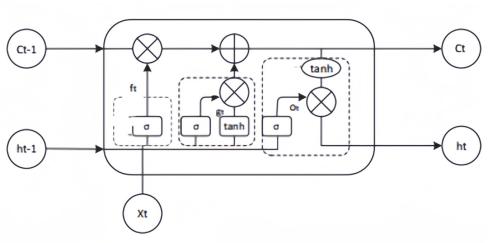
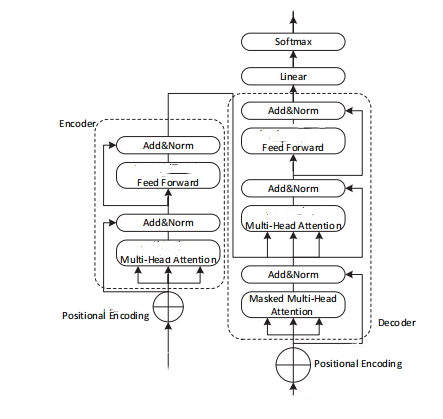
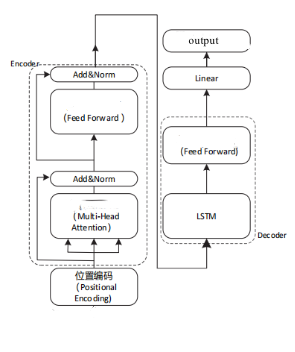
3. System integrator
3.1. Data sources
Taking 25000 tons bulk carrier as an example, the data source of the ship is divided into two ways, one way is to collect data in real time through the outboard environmental sensors, [4]and input the data into the Transformer-LSTM model after processing to generate the theoretical optimal carbon emission baseline value, as shown in Table 1; the other way is to set up the optimal operating parameter interval of the quadruple-supply device, and to realize real-time collection and transmission of operating data by relying on a series of networked and distributed high-precision sensor arrays and intelligent transmission units, as shown in Table 2 [5].The other way is to set the optimal operating parameter interval of the quadruple-supply device, relying on a series of networked distributed high-precision sensor arrays and intelligent transmission units to realize the real-time collection and transmission of operating data, as in Table 2 [6].
|
Sensor type |
Sensor Model |
measured variable |
Measurement range |
|
GPS sensor |
Garmin GPS 18X HS |
Longitude, latitude |
0-180° (longitude), 0-9° (latitude) |
|
Ship Speed Sensor |
S518 |
ship's speed |
0-30 sections |
|
Rudder Angle Sensor |
Koden KMC-170 |
helm angle |
-180° to 180° |
|
Wind Speed Sensor |
Young 05103 |
air velocity |
0-60 m/s |
|
Water velocity sensors |
RDI Workhorse |
water velocity |
0-3 m/s |
|
Draught Depth Sensor |
Aanderaa RCM 9 |
draft |
0-20 meters |
|
Wave Sensor |
SubC Wave |
Wave Significant Height |
0-5 meters |
|
temperature sensor |
Omega 320-1 |
sea surface temperature |
-20°C to 50°C |
|
Carbon dioxide sensors |
Aeroqual Ozone Series |
Carbon dioxide concentration |
0-5000 ppm |
|
Buoy Sensor |
Aanderaa 426 |
depth (of waterway) |
0-30 meters |
|
Crew Module |
Sensor Name |
model number |
Range/Parameter |
|
ORC two-stage generator sets |
thermocouples |
WRNK-431 |
0-450°C |
|
Pressure Transmitter |
Rosemount 3051S |
0-60bar |
|
|
Three-effect absorption heating and cooling units |
Solution Concentration Sensor |
Anton Paar DMA 4500M |
0-60wt% LiBr |
|
Pressure sensors |
WIKA S-20 |
0-1500mmHg |
|
|
Desalination unit |
Salinity Monitor |
HACH SL1000 |
0-50PSU |
|
Energy Efficiency Management Platform |
Temperature Acquisition Module |
Niagara Tridium TAH201 |
PT100 input |
|
smart meter |
Siemens 7KM2112 |
0-690V AC |
|
|
Special Sensors |
Efficiency Sensor Set |
Fluke 2680A + Promass 83 |
Heat flow 0-2000W/m² |
3.2. Construction of transformer-LSTM-based multidimensional time series modeling
3.2.1. Preprocessing of data
The data in this study comes from Shanghai Maritime University Yuming ship internship bulk carrier, including the current ship's navigation status, marine environmental parameters and main engine and auxiliary engine energy consumption indexes of a total of 23 types of input data, so it is necessary to preprocess and construct a multi-dimensional time column input suitable for deep learning, such as Table 3.
|
feature category |
Example of Input Data Containing Fields |
Pre-processing methods |
|
ship's condition |
Speed, ROT, Draught |
Z-score standardization |
|
marine environment |
Wind_Speed, mean_wave_period |
Standardized + sliding average smoothing |
|
Orientation parameters |
Relative Wind Direction |
Sine-cosine coding |
|
geographic location |
Lon, Lat |
Original value retained |
|
thermodynamic parameter |
sea_surface_temperature |
standardization |
Equate the original date variable to hour, day_of_week, and month, and use sine-cosine coding to eliminate breakpoints with periodicity:


Z-score normalization of variable features such as Speed, Wind_Speed, and Draught:

Decompose the variables related to direction angle such as Relative Wind Direction and Relative Current Direction into two-dimensional vectors:


The raw values of Lon and Lat, which are geographic features, are retained directly for modeling regional differences in ocean conditions.
Outliers will be detected using a modified Hampel filter where MAD (Median Absolute Deviation) is defined as

3.2.2. Model architecture setup
In this paper, we innovatively propose Transformer-LSTM hybrid architecture on ships as in Figure. 6, which fuses global dependency modeling with local temporal pattern capturing capability.
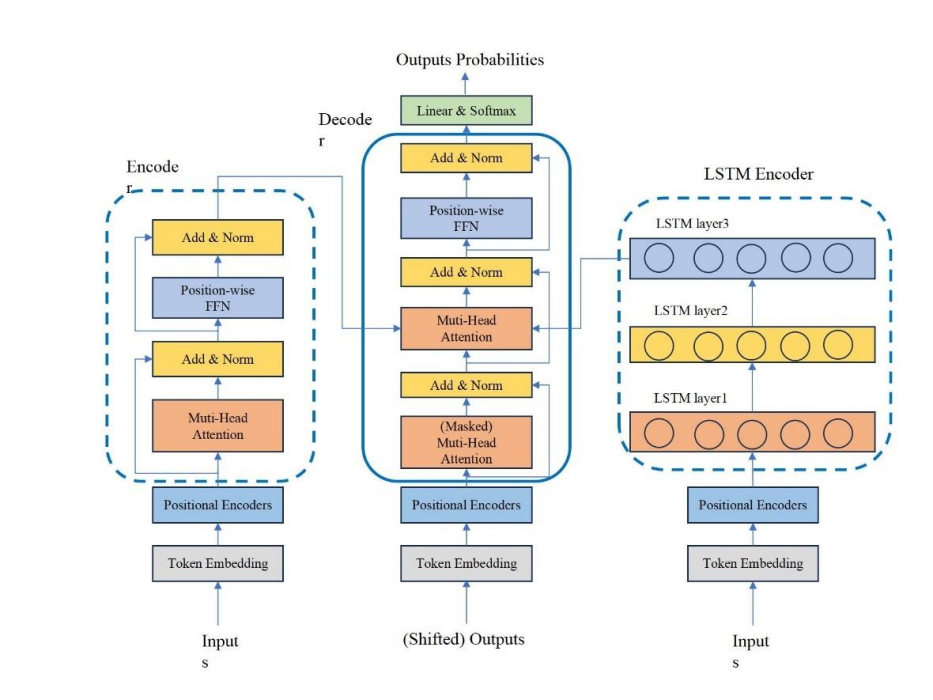
①Input Layer:
Tensor dimension:



②Transformer encoding module:
Multi-head self-attention mechanism: set up 8 attention heads,

Positional coding: using a coding matrix capable of learning

Layer with residual linking: the output of each layer is:

where the FFN in the feedforward network contains two fully connected layers with dimensions from 265 to 23 and an activation function of GULU.
③LSTM timing modeling module:
Receive the context-enhanced sequence output by Transformer

④ output layer:
where the hidden state will be mapped through the fully connected network CO2 predicted value:

among others
3.2.3. Results of model predictions
Experimental results (Figure.7) demonstrate that the Transformer-LSTM hybrid model significantly outperforms the single LSTM model, reducing MAE and RMSE by 7.8% and 14.1% respectively (p<0.05), while MAPE decreased sharply from 136.3% to 57.0%, [7] indicating qualitative improvement in learning ship emission features. The R² increase from 0.12 to 0.33 validates the model's capability to analyze complex operational condition-carbon emission correlations. Technically, the Transformer's multi-head attention captures long-period features (e.g., speed, sea state) while LSTM gating maintains sensitivity to micro-dynamics (e.g., engine load), synergistically enabling multi-scale feature modeling [8].This reduces single-voyage carbon emission errors by ~2.3 tons, significantly enhancing quadruple-supply system control accuracy and providing a credible data baseline for dynamic scheduling optimization.
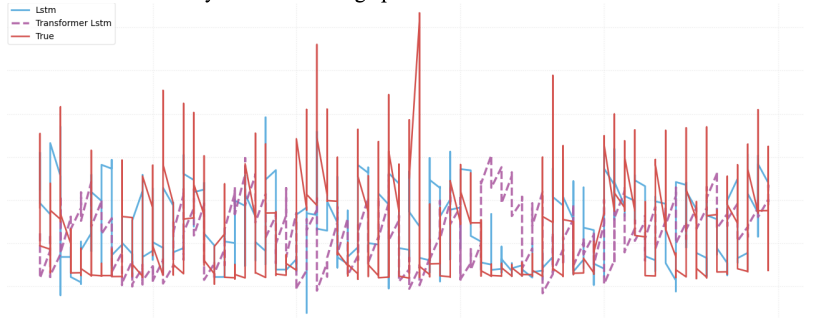
3.3. Construction of dynamic scheduling algorithms for quadruple-supply
This project constructs an intelligent scheduling model for the quadruple-heating system (power generation, refrigeration, heating, seawater desalination) using a Python-based core framework. The model integrates multi-physical field parameters (e.g., flue gas temperature: 350-390°C, jacket water temperature: 90°C) and employs a multi-objective optimization architecture targeting emission reduction, energy efficiency, heat utilization, and freshwater production. Real-time calculation via a weight mapping dictionary generates Pareto-optimal solutions, trained using the Adam optimizer (1000 iterations, varied strategy ratios) [9].

3.4. Summary of innovations
This study pioneers the integration of a Transformer-LSTM model with a quadruple-function waste heat recovery system for retrofitting aging ocean-going bulk carriers. The core innovation is a dual-channel intelligent synergy control architecture (Figure. 9) [10]. The environmental regulation channel utilizes outboard sensors and the Transformer-LSTM model to dynamically generate an optimal carbon emission baseline, triggering actuator adjustments to the recovery system upon significant deviations. Concurrently, the process regulation channel employs high-precision internal sensors to monitor equipment performance and issue corrective commands during abnormal fluctuations [7]. This dual-loop mechanism synergistically links real-time environmental conditions with internal system responses, significantly enhancing dynamic regulation, stability [11].
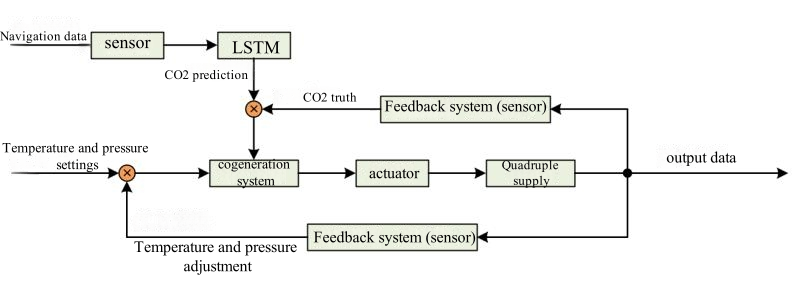
4. Conclusion
The proposed dual-channel intelligent control framework, combining Transformer-LSTM-based carbon prediction with an advanced quadruple-supply waste heat system, represents a significant step forward in intelligent maritime energy management. This approach not only improves predictive accuracy and energy utilization under complex marine conditions, but also delivers a scalable, retrofittable pathway for legacy vessels to meet increasingly stringent decarbonization mandates [12].
In the broader context, this integrated architecture addresses key bottlenecks in current maritime emission control—namely, the limited predictive capabilities of conventional models and the insufficient coordination across onboard energy systems [13]. By linking emission forecasting with dynamic system scheduling, the solution ensures consistent compliance with EEXI and CII standards while enhancing fuel economy and reducing greenhouse gas emissions [14].
Looking ahead, the model holds substantial potential for expansion to other vessel types and energy management scenarios. Future research may further improve the robustness of the control logic under extreme sea states, explore fusion with renewable onboard energy sources, [15] and apply reinforcement learning to autonomously optimize decision-making over longer voyages. Ultimately, this work lays a technical foundation for achieving the IMO 2050 decarbonization goals through intelligent, data-driven ship operations [16].
References
[1]. HUANG Jinjie, JIANG Zhaoming, LU Junbing. Response to EEDI, EEXI and CII indices [J]. Navigation, 2023(2): 58-64.
[2]. ZHAO Hai-Li, LI Shan-Wen, ZHANG Dat-Tian, et al. Case study of silicone antifouling paint Hempaguard on real ships EEXI and CII [J]. Modern Coatings and Painting, 2025, 28(1): 21-23+40.
[3]. GUI Binglin, LIU Chunyu, LIU Jiapeng. Multifactor carbon emissions trading price prediction based on Transformer-LSTM model [J]. Price Monthly, 2024, (5): 49-57.DOI: 10.14076/j.issn.1006-2025.2024.05.06.
[4]. Chen, Zhongdu, Xu, Chunchun, Ji, Long, et al.Carbon footprint analysis of double cropping rice production in the middle Yangtze River Valley based on household surveys [J].Chinese Journal of Rice Science, 2018, 32(6): 601-609.DOI: 10.16819/j.1001-7216.2018.7080.
[5]. HsiaoHwa Chen, Yi Qian, Sheng Zhou.ENERGY CONSERVATION AND HARVESTING FOR GREEN COMMUNICATIONS [J].China Communications, 2014, 11(3): I0001-I0002.
[6]. Ma Li.A Greener Path [J].Beijing Review, 2016, 59(18): 36-37.
[7]. MOST Developed Software of Counter of Energy Conservation and Emission Reduction for Public [J].Chinese Journal of Population, Resources and Environment, 2008, 6(2): F0003-F0003.
[8]. Li, Zhengze, Chen, Xuan, She, Anming, et al.Adjusting LCA Allocation Methods for Cement Industry: A Production-Based Approach to Energy Conservation and Emission Reduction [J].MATERIALS, 2025, 18(11).DOI: 10.3390/ma18112483.
[9]. Berselli, Luigi C., Chiodaroli, Elisabetta, Sannipoli, Rossano.Energy Conservation for 3D Euler and Navier-Stokes Equations in a Bounded Domain: Applications to Beltrami Flows [J].JOURNAL OF NONLINEAR SCIENCE, 2025, 35(1).DOI: 10.1007/s00332-024-10102-x.
[10]. Sun, Mulin, Fu, Yuhao, Sun, Mingyao, et al.Study on Key Influencing Factors of Carbon Emissions from Farmland Resource Utilization in Northeast China Under the Background of Energy Conservation and Emission Reduction [J].ENERGIES, 2025, 18(2).DOI: 10.3390/en18020277.
[11]. Wang, Chun-Chun, Wang, Yuan, Zhu & amp; Xiao-Dong.(2019).Peak volume and time of energy-related CO2 emissions in Jiangsu Province, China based on long-range energy alternatives planning system model.Ying yong sheng tai xue bao = The journal of applied ecology, 30(10), 3535-3543.DOI: 10.13287/j.1001-9332.201910.017.
[12]. Suo, Liang, Li, Shugang, Wu, Fengliang, et al.The Effect of Distance between Jet Fans on Gas Transport, Energy Conservation, and Emission Reduction in Long Highway Tunnels [J].SUSTAINABILITY, 2024, 16(16).DOI: 10.3390/su16166990.
[13]. Xu, Xingshuo, Zhou, Chang, Tan, Yansi, et al.Analyzing the Diversion Effect of Debris Flow in Cross Channels Utilizing Two-Phase Flow Theory and the Principle of Energy Conservation [J].WATER, 2024, 16(15).DOI: 10.3390/w16152134.
[14]. Harini, R., Indhira, K..Dynamical modelling and cost optimization of a 5G base station for energy conservation using feedback retrial queue with sleeping strategy [J].TELECOMMUNICATION SYSTEMS, 2024, 86(4): 661-690.DOI: 10.1007/s11235-024-01155-0.
[15]. Zhang, Yingbin, Li, Xiaoqin, Fu, Junwen, et al.Quick analysis model for earthquake-induced landslide movement based on energy conservation [J].LANDSLIDES, 2024, 21(6): 1315-1331.DOI: 10.1007/s10346-024-02223-x.
[16]. Conte, Dajana, and FrascaCaccia, Gianluca."Exponentially fitted methods with a local energy conservation law." ADVANCES IN COMPUTATIONAL MATHEMATICS 49.04(2023).DOI: 10.1007/s10444-023-10049-9.
Cite this article
Pan,Y.;Wei,P.;Chen,Z. (2025). Optimization Study of Carbon Emission Reduction from Ships Based on EEXI and CII Frameworks: Synergistic Application of Transformer-LSTM Model and Quadruple Waste Heat System. Applied and Computational Engineering,180,72-82.
Data availability
The datasets used and/or analyzed during the current study will be available from the authors upon reasonable request.
Disclaimer/Publisher's Note
The statements, opinions and data contained in all publications are solely those of the individual author(s) and contributor(s) and not of EWA Publishing and/or the editor(s). EWA Publishing and/or the editor(s) disclaim responsibility for any injury to people or property resulting from any ideas, methods, instructions or products referred to in the content.
About volume
Volume title: Proceedings of CONF-MCEE 2026 Symposium: Advances in Sustainable Aviation and Aerospace Vehicle Automation
© 2024 by the author(s). Licensee EWA Publishing, Oxford, UK. This article is an open access article distributed under the terms and
conditions of the Creative Commons Attribution (CC BY) license. Authors who
publish this series agree to the following terms:
1. Authors retain copyright and grant the series right of first publication with the work simultaneously licensed under a Creative Commons
Attribution License that allows others to share the work with an acknowledgment of the work's authorship and initial publication in this
series.
2. Authors are able to enter into separate, additional contractual arrangements for the non-exclusive distribution of the series's published
version of the work (e.g., post it to an institutional repository or publish it in a book), with an acknowledgment of its initial
publication in this series.
3. Authors are permitted and encouraged to post their work online (e.g., in institutional repositories or on their website) prior to and
during the submission process, as it can lead to productive exchanges, as well as earlier and greater citation of published work (See
Open access policy for details).
References
[1]. HUANG Jinjie, JIANG Zhaoming, LU Junbing. Response to EEDI, EEXI and CII indices [J]. Navigation, 2023(2): 58-64.
[2]. ZHAO Hai-Li, LI Shan-Wen, ZHANG Dat-Tian, et al. Case study of silicone antifouling paint Hempaguard on real ships EEXI and CII [J]. Modern Coatings and Painting, 2025, 28(1): 21-23+40.
[3]. GUI Binglin, LIU Chunyu, LIU Jiapeng. Multifactor carbon emissions trading price prediction based on Transformer-LSTM model [J]. Price Monthly, 2024, (5): 49-57.DOI: 10.14076/j.issn.1006-2025.2024.05.06.
[4]. Chen, Zhongdu, Xu, Chunchun, Ji, Long, et al.Carbon footprint analysis of double cropping rice production in the middle Yangtze River Valley based on household surveys [J].Chinese Journal of Rice Science, 2018, 32(6): 601-609.DOI: 10.16819/j.1001-7216.2018.7080.
[5]. HsiaoHwa Chen, Yi Qian, Sheng Zhou.ENERGY CONSERVATION AND HARVESTING FOR GREEN COMMUNICATIONS [J].China Communications, 2014, 11(3): I0001-I0002.
[6]. Ma Li.A Greener Path [J].Beijing Review, 2016, 59(18): 36-37.
[7]. MOST Developed Software of Counter of Energy Conservation and Emission Reduction for Public [J].Chinese Journal of Population, Resources and Environment, 2008, 6(2): F0003-F0003.
[8]. Li, Zhengze, Chen, Xuan, She, Anming, et al.Adjusting LCA Allocation Methods for Cement Industry: A Production-Based Approach to Energy Conservation and Emission Reduction [J].MATERIALS, 2025, 18(11).DOI: 10.3390/ma18112483.
[9]. Berselli, Luigi C., Chiodaroli, Elisabetta, Sannipoli, Rossano.Energy Conservation for 3D Euler and Navier-Stokes Equations in a Bounded Domain: Applications to Beltrami Flows [J].JOURNAL OF NONLINEAR SCIENCE, 2025, 35(1).DOI: 10.1007/s00332-024-10102-x.
[10]. Sun, Mulin, Fu, Yuhao, Sun, Mingyao, et al.Study on Key Influencing Factors of Carbon Emissions from Farmland Resource Utilization in Northeast China Under the Background of Energy Conservation and Emission Reduction [J].ENERGIES, 2025, 18(2).DOI: 10.3390/en18020277.
[11]. Wang, Chun-Chun, Wang, Yuan, Zhu & amp; Xiao-Dong.(2019).Peak volume and time of energy-related CO2 emissions in Jiangsu Province, China based on long-range energy alternatives planning system model.Ying yong sheng tai xue bao = The journal of applied ecology, 30(10), 3535-3543.DOI: 10.13287/j.1001-9332.201910.017.
[12]. Suo, Liang, Li, Shugang, Wu, Fengliang, et al.The Effect of Distance between Jet Fans on Gas Transport, Energy Conservation, and Emission Reduction in Long Highway Tunnels [J].SUSTAINABILITY, 2024, 16(16).DOI: 10.3390/su16166990.
[13]. Xu, Xingshuo, Zhou, Chang, Tan, Yansi, et al.Analyzing the Diversion Effect of Debris Flow in Cross Channels Utilizing Two-Phase Flow Theory and the Principle of Energy Conservation [J].WATER, 2024, 16(15).DOI: 10.3390/w16152134.
[14]. Harini, R., Indhira, K..Dynamical modelling and cost optimization of a 5G base station for energy conservation using feedback retrial queue with sleeping strategy [J].TELECOMMUNICATION SYSTEMS, 2024, 86(4): 661-690.DOI: 10.1007/s11235-024-01155-0.
[15]. Zhang, Yingbin, Li, Xiaoqin, Fu, Junwen, et al.Quick analysis model for earthquake-induced landslide movement based on energy conservation [J].LANDSLIDES, 2024, 21(6): 1315-1331.DOI: 10.1007/s10346-024-02223-x.
[16]. Conte, Dajana, and FrascaCaccia, Gianluca."Exponentially fitted methods with a local energy conservation law." ADVANCES IN COMPUTATIONAL MATHEMATICS 49.04(2023).DOI: 10.1007/s10444-023-10049-9.











